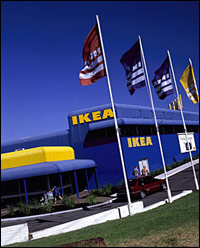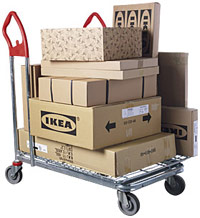
Green by design.
Photo: IKEA
Last week, IKEA U.S. announced a “bag the plastic bag” initiative: the retailer will charge a nickel for plastic bags to discourage their use, donating all revenue to the nonprofit conservation group American Forests. The store will also let shoppers walk away with one of its iconic reusable blue bags for 59 cents. Pleasant enough news, but it struck me as somewhat cosmetic. Hadn’t I heard that IKEA’s commitment to sustainability went much further than this?
A little poking around on the IKEA website uncovered a set of practices that puts every big U.S. retailer to shame. From the wood in its products to the factory conditions of its suppliers to the energy efficiency of its distribution network, IKEA has outlined tough, progressive standards almost unheard of in the U.S. Now it’s working to move all its stores to completely renewable energy.
Why not brag about that stuff instead of the bags? I contacted IKEA’s head of social and environmental responsibility, Thomas Bergmark, at the company’s headquarters in Sweden to find out the details behind this unassuming approach.
Tell me a little bit about this initiative in the U.S. with the plastic bags.

Thomas Bergmark.
It might be the first campaign where we are more on the offense. The basic strategy not only in the U.S. but in all our markets has been to be quiet, low-key. We should first do and then talk. We have from time to time been a bit criticized because we have been too quiet. Different stakeholders have realized that we try hard and we do a lot — so why don’t we talk about it? We have now for three years issued a yearly social and environmental report on the web. We communicate more in different kinds of media, of course in the catalogue and in IKEA family magazines for our customer club and so forth. This campaign is one step in that direction, to be more aggressive and more transparent in these issues.
How does IKEA view its obligation to the environment?
We have a vision for business that was written more than 30 years ago. It’s about creating a better everyday life for the people. Today, it’s obvious to care about the people, you have to care about the environment.
The starting point for our sustainability is the people and the culture. We have a very strong company culture. One of the cornerstones since IKEA was founded more than 60 years ago is to care about resources — we are clever with resources. For the first 20 years, this was only about turning and twisting the materials to utilize them in the best possible way, to save on material and thereby save on costs. But today we know it’s a perfect win-win also for the environment. You save on the resources, you save on the environment. That has evolved over the decades.
Then of course there is the core business side as well. We are more than aware of that. We have to take responsibility for these issues if customers are to trust us today and in the future. We are convinced that if we work hard on sustainability and make progress, it will build trust in our consumers and with the IKEA brand. The culture issues and the business issues meet with the brand and the IKEA logo.
Has IKEA tried to make its stores green?
We’re focusing more and more on that. First of all, we are setting up an IKEA standard, which includes the different steps in establishing a store. The first step is to look into a site, the land and such, to make sure we are not stepping into any sensitive areas that should be protected for biodiversity or other reasons. We consider the building materials we use when building new stores. Now we also consider environmental issues.
Then, of course, it’s about operations — energy, water issues related to the stores. We do a really good job on waste sorting and recycling compared to many other retailers. Then there’s the maintenance of the stores. And at the end of the day, it’s the products we put in the stores.
What we recently started up on an international level is an extra focus on energy. We have set a long-term direction to supply all IKEA buildings with renewable energy, which means electricity and heating. We’re also working on energy efficiency, to get 25 percent more energy efficient.
Will the renewable-energy goal be met by buying offsets, or is there going to be on-site generation as well?
The basic idea is to, as far as possible, produce the energy ourselves, at the sites, with solar, wind, biomass, and geothermal heating/cooling. For new stores, we are looking to build it in. Then for all existing stores, we have to do analysis on the different options of retrofit. Some units might be tricky, and we’ll have to see how to compensate that with carbon credits, or maybe by producing energy at another place and putting it back into the grid — maybe creating a balance like that.
Do you have a specific deadline or target to get to completely renewable energy?
We have set the first step for 2009, where we’re going to reach 60 percent renewable energy and 15 percent more energy efficient. Then, based on analysis we are doing right now, we will set the end goals, hopefully during this calendar year.
One traditional environmental objection to big-box chain stores is that shipping goods from all over the world is incredibly energy intensive. Is that on IKEA’s radar?

Photo: IKEA
Yes, for sure. Distribution is one of the focus areas for IKEA, and has been for quite a few years. What we have done for more than 50 years, which we benefit from still, is the flat pack. We save volume, which is simple but important because it makes a big, big difference in transport work. We’ve had a [producers] code of conduct for more than six years now, about social, environmental, and working conditions. And we have a similar code of conduct now for our transport carriers — one and a half years ago we put requirements in these fields.
Transport is a challenging area. I have to admit, it’s one of the tougher ones to change, because it is a traditional business, where you don’t see too many groundbreaking solutions. What is coming now is more biofuels, and we are supporting that — hopefully we can use more and more biofuels for trucks, especially in the near future.
What about trying to source from local or regional suppliers?
Yes, for sure. One reason for having a trading organization in America is to supply North American stores. Our stores in America are still depending on imports from Europe and Asia, no question about that. But as the market grows and we build more stores, we’ll also increase the possibilities for local sourcing and thereby reduce the shipping [impacts].
Have you encountered resistance from suppliers, or have you found that they’re eager to work with you when you put these kind of social and environmental restrictions on how they operate?
It differs. You can say suppliers in Europe and the Americas are generally more positive. If we speak about Asia, it differs a lot. Some suppliers, they buy the concept right away. Others are very … I would say not resistant but questioning — why should we do this? It is a big job to convince them to start the process.
Some of these suppliers after a while think, no, it’s too much, so they’ll say, we are leaving IKEA. We have to live with that. Other suppliers, they go through a different journey. They explain it like this to me, that when they first got the requirements, they thought it was a lot, but since they had a good experience with IKEA for many years, they thought, these guys from IKEA, they’re clever, so we’ll give it a try. Then they get going. I have a couple of cases of suppliers I have met in Asia that tell me, “You know what happened next? I got a couple of new potential customers visiting my factory the other week, and they asked about code of conduct issues and environmental and working conditions. And I could show them what I have been doing so far together with IKEA. And I got new business.”
It boils down to what it has to be about at the end of the day: business. It has to be about improving conditions in the factories, for people and the environment, and at the end of the day also improving the productivity and competitiveness of the suppliers.
Are you going to try to ramp up communications and PR around environmental issues?
Yeah, communications and information. We’re definitely not the company that wants to ring the big bell and do a lot of heavy marketing. Actions like the blue bag campaign, now, that’s fine, but you will not see campaigns on billboards. We will make information about our sustainability efforts more easily available to different stakeholders, including the customers in our stores. That we are working on — to be more transparent, to be more visible in these issues. It’s expected from our customers.


